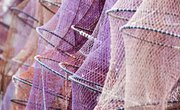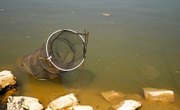
Catfish can be caught using many different styles, including rod and reel, hand fishing --- also known as noodling --- and traps. Trapping is a passive way of catching fish. The trap sets and waits for a catfish to enter with very little work from the trapper required. Making catfish traps is a fairly simple task that can be completed in short period of time. Trapping catfish is not legal in all states. It is important to check with your state laws prior to creating and trapping any fish.
Items you will need
Wire mesh
Wire
Wire cutters
Rope
Rocks
Bait
Determine if it is legal to trap catfish. Many states have laws regarding the trapping of fish. Check with your state's Fish and Game Department to find out any regulation regarding trapping of catfish in your area.
Cut wire mesh into six rectangular sections. Any wire mesh purchased from a hardware store should do. The holes in the mesh need to be small enough to not let the fish escape through them.
String wire through each section of the wire mess to create a box. The size of the box will be determined where you fish. Catfish prefer areas with slow-moving current. The sides of ponds and lake shorelines are great spots to fish. The trap does not need to be large and should be easy to set and access.
Cut a square hole in the back of the trap so that the fish can be removed after it is trapped. Replace the cut-out section and attach with wire. Create a hinge on top by looping the wire continuously. Use the wire to create a loop or a latch to hold the screen in place.
Cut to lines in the shape of an "X" into the front of the trap. Push the sections toward the inside of the trap. This will allow the catfish to enter into the trap. The sharp sections created by the cuts will keep the catfish from escaping.
Bait the trap with dead fish, bread or corn; catfish are not picky eaters. The bait should be located at the back of the trap, enticing the fish to enter. Add rocks to the bottom of the trap if it needs to be weighted down. Attach a rope to the trap that is then attached to something permanent, such as an anchor in the water or a tree on land.
Tips
- For best results, let the trap sit at least one full night before checking it.
References
Tips
- For best results, let the trap sit at least one full night before checking it.
Writer Bio
Michael Carpenter has been writing blogs since 2007. He is a mortgage specialist with over 12 years of experience as well as an expert in financing, credit, budgeting and real estate. Michael holds licenses in both real estate and life and health insurance.



